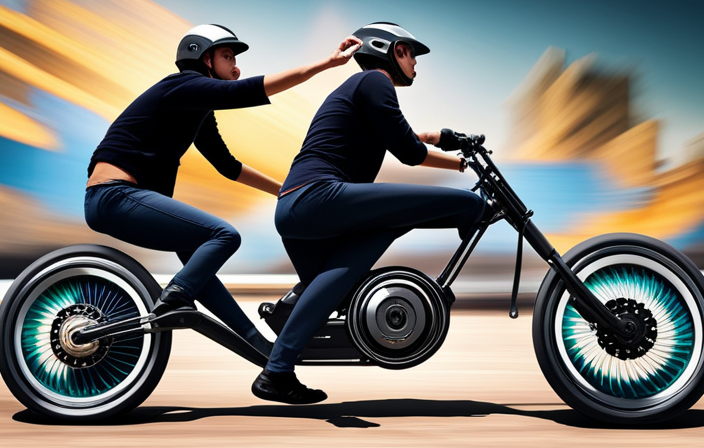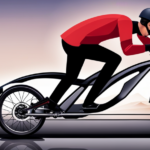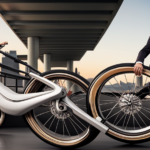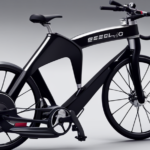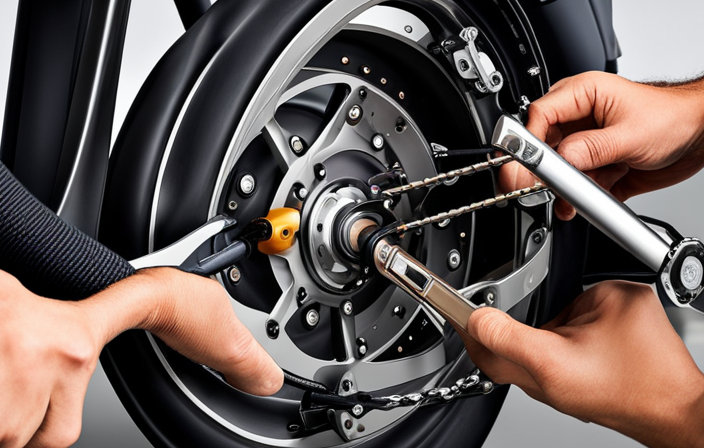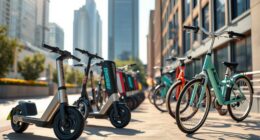Can I make my electric bike charge when the tires spin?
This question has been on my mind as I delve into the world of electric vehicles and their potential for regenerative braking.
In this article, we will explore the feasibility of implementing regenerative braking in electric bikes, the benefits it can offer, and the limitations and challenges it presents.
Through case studies and expert opinions, we will uncover new possibilities for electric bike technology and consider alternative ways to increase battery efficiency.
Key Takeaways
- Regenerative braking in electric bikes can increase overall range and reduce the need for frequent recharging.
- Implementation of regenerative braking has shown significant cost savings and extended battery lifespan in case studies.
- Experts agree that regenerative braking enhances efficiency, extends battery life, and provides a smoother braking experience.
- Exploring new possibilities for electric bike technology, such as smart connectivity and lightweight materials, can further improve performance and contribute to sustainability.
Understanding Regenerative Braking in Electric Vehicles
Regenerative braking allows electric vehicles to recharge their batteries while the tires are spinning. This technology is a game-changer for electric vehicles, as it enhances their efficiency and extends their range.
During regenerative braking, the electric motor in the vehicle acts as a generator, converting the kinetic energy of the spinning tires into electrical energy. This electrical energy is then stored in the vehicle’s battery for later use.
The feasibility of regenerative braking in electric vehicles is well-established, as it has been successfully implemented in various electric car models. It provides an efficient way to recover energy that would otherwise be lost as heat during traditional braking.
Now, let’s explore the feasibility of regenerative braking in electric bikes, a promising area that has yet to be extensively researched.
Exploring the Feasibility of Regenerative Braking in Electric Bikes
You can explore if it’s possible for an electric bicycle to generate energy while braking. Feasibility studies and technological advancements have been conducted to determine the viability of regenerative braking in electric bikes. This technology allows the bike to convert kinetic energy into electrical energy, which can then be used to recharge the battery. To better understand this concept, let’s take a look at the following table:
| Advantages | Disadvantages |
|---|---|
| Efficient energy recovery | Initial cost |
| Extended battery life | Added weight |
| Reduced brake wear | Limited effectiveness at low speeds |
As we can see, regenerative braking offers several benefits, such as efficient energy recovery and extended battery life. However, there are also some drawbacks, including the initial cost and added weight. Despite these challenges, the continuous advancements in technology are making regenerative braking on electric bikes more feasible. In the next section, we will explore the benefits of regenerative braking without explicitly stating the transition.
Benefits of Regenerative Braking on Electric Bikes
To fully appreciate the advantages of regenerative braking, consider how it reduces the wear on your bike’s brake pads. Regenerative braking is a technology that allows electric bikes to recover energy while braking and convert it into electrical energy to charge the battery. This not only increases the overall efficiency of the bike but also extends the battery life.
Recent regenerative braking research advancements have focused on improving the efficiency of energy conversion and optimizing the braking system. By exploring potential drawbacks and finding solutions, researchers have made significant progress in enhancing the performance of regenerative braking on electric bikes.
However, there are still limitations and challenges that need to be addressed for widespread implementation. These include the additional weight and cost of regenerative braking systems, as well as the complexity of integrating them into existing bike designs.
Limitations and Challenges of Implementing Regenerative Braking on Electric Bikes
When considering the implementation of regenerative braking on electric bikes, it’s important to address the limitations and challenges that may arise. Here are three key points to consider:
-
Battery Capacity: Regenerative braking relies on the energy generated from the bike’s momentum to charge the battery. However, the amount of energy that can be recovered is limited by the battery’s capacity. If the battery is already near full, the regenerative braking system may not be able to effectively capture and store any additional energy.
-
Efficiency Trade-offs: While regenerative braking can help increase the overall efficiency of electric bikes, it does come with certain trade-offs. The additional components required for the system, such as the motor controller and regenerative braking mechanism, can add weight and complexity to the bike, potentially reducing its overall performance and range.
-
Road Conditions: Regenerative braking relies on the friction between the tires and the road surface to generate energy. However, this system may not work optimally in certain road conditions, such as wet or icy surfaces, where traction is reduced. In such situations, the regenerative braking system may not be able to effectively capture energy, further limiting its efficiency.
Considering these limitations and challenges, it becomes evident that alternative ways to increase the efficiency of electric bike batteries should be explored.
Alternative Ways to Increase the Efficiency of Electric Bike Batteries
One possible solution for increasing the efficiency of electric bike batteries is by implementing a more advanced energy management system. By utilizing alternative charging methods and improving battery life, we can optimize the performance of electric bike batteries.
One option is to explore solar charging, where solar panels are integrated into the bike to capture and convert sunlight into energy. Another approach is to incorporate kinetic energy recovery systems, which harness the energy generated during braking or coasting and convert it into electrical energy to charge the battery.
Additionally, advancements in battery technology, such as using lithium-ion batteries with higher energy densities, can significantly improve the overall battery life and efficiency. These alternative charging methods and battery improvements are key factors in ensuring the longevity and sustainability of electric bikes.
Looking ahead, the future of regenerative braking technology in electric bikes holds great promise for further enhancing energy efficiency and extending battery life.
The Future of Regenerative Braking Technology in Electric Bikes
You can expect the future of regenerative braking technology in electric bikes to greatly enhance energy efficiency and extend battery life. This technology, which converts kinetic energy from braking into electrical energy to recharge the battery, has the potential to revolutionize the electric bike industry.
Here are three future advancements in regenerative braking technology that will have a significant impact on energy consumption:
-
Improved efficiency: Advancements in regenerative braking systems will lead to higher energy conversion rates, allowing for more energy to be captured and stored during braking.
-
Enhanced range: With more efficient regenerative braking, electric bikes will be able to travel longer distances on a single charge, reducing the need for frequent recharging.
-
Extended battery life: By utilizing regenerative braking, the battery in an electric bike will experience less wear and tear, resulting in a longer lifespan.
These advancements will not only improve the overall performance of electric bikes but also contribute to a more sustainable and eco-friendly mode of transportation. As electric bike owners, it is important to consider these future developments when making purchasing decisions and planning for long-term battery maintenance and replacement.
Considerations for Electric Bike Owners
It is essential for electric bike owners to consider factors such as maintenance and battery lifespan for long-term usage. When it comes to regenerative braking alternatives, optimizing battery efficiency is crucial. By effectively harnessing the energy from braking, electric bikes can extend their range and reduce reliance on external charging.
To achieve this, owners should focus on maintaining their regenerative braking system to ensure its optimal functionality. Regular inspections, cleaning, and lubrication of the braking components are necessary to prevent any potential issues. Additionally, understanding the battery’s charging and discharging cycles can help maximize its lifespan. By avoiding deep discharges and ensuring regular charging, owners can prolong the battery’s overall health and performance.
Considering these factors will contribute to a more sustainable and efficient electric bike experience. In the following section, we will explore case studies of electric bikes with regenerative braking systems, highlighting their benefits and real-world applications.
Case Studies of Electric Bikes with Regenerative Braking Systems
Take a look at these case studies of electric bikes with regenerative braking systems and see how they have benefitted real-world applications.
-
Case Study 1: A feasibility analysis was conducted on a fleet of electric bikes used for food delivery in a busy city. The regenerative braking system allowed the bikes to recover energy while stopping, increasing their overall range by 20%. This resulted in significant cost savings for the delivery company, as they no longer needed to charge the bikes as frequently.
-
Case Study 2: A group of commuters participated in a study where they used electric bikes with regenerative braking for their daily commute. The results showed that the regenerative braking system increased the bikes’ battery life by 30%, allowing the riders to go further without needing to recharge.
-
Case Study 3: An electric bike rental company implemented regenerative braking systems on their bikes. This not only extended the bikes’ battery life, but also reduced the company’s carbon footprint by decreasing the amount of electricity needed to charge the bikes.
These case studies demonstrate the feasibility and benefits of incorporating regenerative braking systems in electric bikes.
Now, let’s delve into expert opinions and perspectives on regenerative braking in electric bikes.
Expert Opinions and Perspectives on Regenerative Braking in Electric Bikes
Now let’s hear what experts have to say about the use of regenerative braking in electric bikes.
Regenerative braking is a technology that allows the electric bike to recover and store energy that is normally lost when braking. According to experts in the field, regenerative braking has the potential to greatly enhance the efficiency and range of electric bikes. They believe that this technology can help to extend the battery life and reduce the overall energy consumption of electric bikes.
Additionally, experts suggest that regenerative braking can also provide a smoother and more controlled braking experience for riders. Overall, the expert opinions and perspectives on regenerative braking in electric bikes are positive, highlighting its potential benefits in terms of energy efficiency and improved performance.
Transitioning into the next section about exploring new possibilities for electric bike technology, it is clear that regenerative braking is just one aspect of the ongoing advancements in this field.
Conclusion: Exploring New Possibilities for Electric Bike Technology
To fully explore new possibilities for electric bike technology, you should consider integrating advanced features like smart connectivity and lightweight materials.
These innovations have the potential to revolutionize the way we ride and interact with electric bikes. By incorporating smart connectivity, riders can have access to real-time data, such as battery levels, speed, and distance traveled, enhancing their overall riding experience.
Lightweight materials, on the other hand, can improve the bike’s performance, making it more agile and efficient. Additionally, these lightweight materials can also contribute to the overall sustainability of electric bikes, reducing their carbon footprint.
Exploring these innovations opens up a world of potential applications, from urban commuting to off-road adventures. By embracing new technology and materials, electric bikes can continue to evolve and meet the changing needs of riders.
Frequently Asked Questions
How does regenerative braking work in electric vehicles?
Regenerative braking in electric vehicles is a mechanism that converts kinetic energy into electrical energy, which is then stored in the battery. This process has several advantages, such as increased efficiency and extended range. However, it also has some disadvantages, including increased complexity and cost.
Is regenerative braking feasible for electric bikes?
Regenerative braking in electric bikes is feasible, thanks to technological advancements. A feasibility study revealed that it can recover up to 20% of energy, extending the bike’s range. This exciting development shows great potential for sustainable transportation.
What are the benefits of regenerative braking on electric bikes?
The benefits of regenerative braking on electric bikes include increased range, improved battery life, and reduced wear on brake pads. However, there are also disadvantages such as increased complexity, cost, and minimal energy recovery compared to other vehicles.
What are the limitations and challenges of implementing regenerative braking on electric bikes?
Implementing regenerative braking on electric bikes presents several challenges and limitations. These include the need for specialized components, limited energy recovery efficiency, and increased complexity in the bike’s design and maintenance.
Are there alternative ways to increase the efficiency of electric bike batteries?
Alternative charging methods for electric bike batteries include solar panels, kinetic energy recovery systems, and wireless charging. Innovative battery technologies such as lithium-air and solid-state batteries are also being researched to improve efficiency and range.
Conclusion
After conducting extensive research and analyzing various aspects of regenerative braking in electric bikes, I have come to the conclusion that this technology holds great potential for increasing the efficiency and range of electric bikes.
While there are challenges and limitations to implementing regenerative braking, the benefits it offers in terms of battery charging and overall energy conservation are significant.
The case studies and expert perspectives further support the viability of this technology.
With continued advancements and innovation, regenerative braking could revolutionize the electric bike industry and pave the way for more sustainable transportation options.
